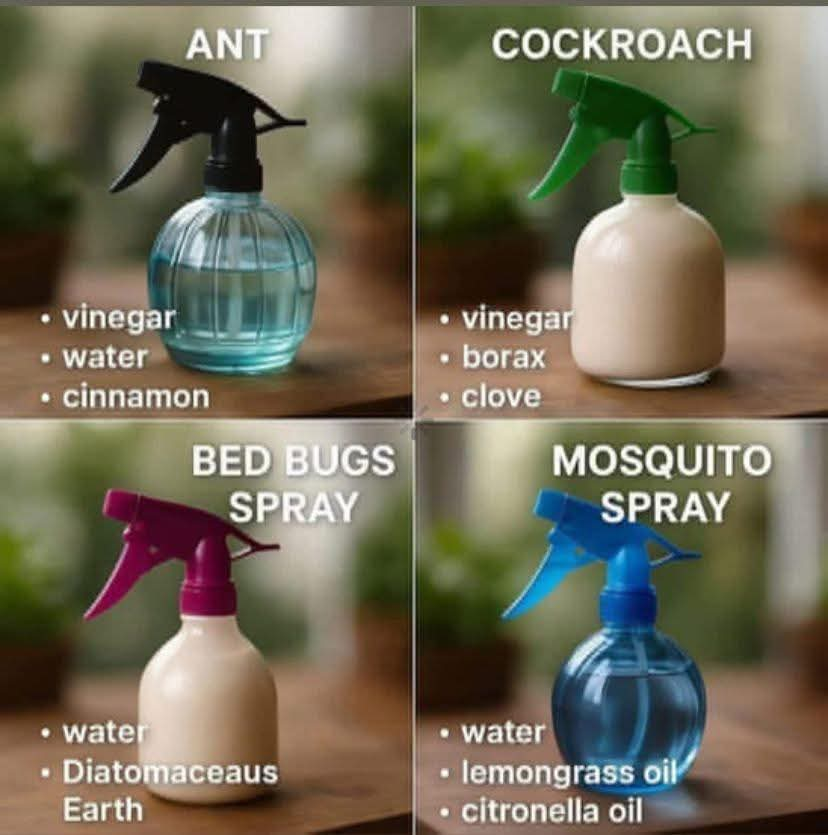Certainly! Here’s the complete structured write-up for your Natural Mosquito Spray, following your specified format:
Say Goodbye to Ants, Cockroaches, Bed Bugs & Mosquitoes—Naturally!
Mosquito Spray
Introduction
Mosquitoes are more than just annoying; they can also carry serious diseases like dengue, malaria, and West Nile virus.
While commercial mosquito repellents are widely available, many contain chemicals like DEET that some people may wish to avoid.
For those seeking a natural solution, essential oils offer an effective and fragrant way to keep mosquitoes at bay.
Ingredients
Mix 1 cup water + 10 drops lemongrass oil
Add 10 drops citronella oil
Tip: Spray near windows, doors, and around lights.
Instructions
Start by preparing a clean spray bottle. Choose one that produces a fine mist to ensure the spray distributes evenly across the skin or area being treated. Make sure it’s empty and free of residue from any previous use.
Pour one cup of clean water into the bottle. You can use distilled or filtered water for better purity and a longer shelf life. Room temperature water works best for blending with oils.
Add ten drops of lemongrass essential oil to the water. Lemongrass has a fresh citrusy scent that mosquitoes dislike, and it acts as a primary repellent ingredient.
Follow with ten drops of citronella essential oil. This oil has been used for decades to repel mosquitoes and is commonly found in outdoor candles and sprays.
Secure the cap on the bottle and shake it vigorously. Essential oils and water naturally separate, so thorough shaking is needed to temporarily mix them.
Test a small spray on your wrist or fabric to ensure there’s no irritation or staining. This is especially important if you’re using the spray on clothing or sensitive skin.
Spray lightly on exposed skin, clothing, window sills, patio furniture, or wherever mosquitoes tend to gather. Avoid spraying near the eyes or mouth.
How to Make
Choose a dark or tinted spray bottle if possible, as this helps protect the essential oils from light and extends the spray’s effectiveness. Glass bottles are also a great eco-friendly option.
Ensure the bottle is completely clean and dry before adding ingredients. Any leftover residue from other sprays or cleaners can interfere with the mixture and reduce its power.
Pour the water into the bottle slowly to avoid spills. If you’re making a larger batch, adjust the proportions accordingly but maintain the same ratio of oils to water.
Add the essential oils one by one. If you’re sensitive to strong scents, you can begin with fewer drops and increase based on your comfort level.
Close the bottle tightly and shake well to mix. Because oil and water don’t mix naturally, this step is critical each time before use to ensure proper distribution.
Label the spray bottle with the ingredients and date. Natural sprays don’t contain preservatives, so knowing when you made it can help you decide when to refresh the batch.
Store the bottle in a cool, dry location. Avoid direct sunlight or heat, which can degrade the oils over time and reduce the spray’s effectiveness.
Variations
Add a few drops of eucalyptus or tea tree oil for enhanced insect-repelling qualities. Both oils have strong antimicrobial properties and also smell refreshing.
Replace water with witch hazel or alcohol (like vodka) to help the oils disperse better and provide a quicker-drying formula, especially useful for skin application.
Infuse the water with fresh rosemary, mint, or basil before adding essential oils. Strain thoroughly to avoid clogging your spray nozzle.
Combine it with lavender essential oil for a calming aroma that also offers mosquito-repelling effects. Lavender is gentle and especially suitable for use on children.
Include a tablespoon of apple cider vinegar for extra repelling power. The scent fades quickly but adds an extra layer of defense mosquitoes dislike.
Use lemon eucalyptus oil as a substitute or additional ingredient. It’s recognized by the CDC as an effective natural mosquito repellent.
Create a larger outdoor spray by scaling up the ingredients and storing the solution in a garden sprayer. This is helpful for treating patio furniture or picnic areas.
Tips
Shake the bottle before every use, as the oils will naturally separate from the water over time. Consistent mixing ensures each spray is equally effective.
Apply the spray every couple of hours when outdoors, especially in high-mosquito areas or near dusk and dawn when they are most active.
Avoid direct application to the face. Instead, spray onto your hands and gently pat it on areas like your neck or forehead, keeping it away from eyes and mouth.
If using on children, spray their clothing rather than skin, and always perform a patch test first to check for sensitivities.
Do not spray on open wounds, irritated skin, or sensitive body parts. Even natural oils can cause discomfort if misused.
Reapply after sweating or exposure to water, as moisture can reduce the spray’s staying power and effectiveness.
Keep the spray handy in your bag, car, or outdoor space for quick touch-ups during hikes, barbecues, or evenings on the porch.
Conclusion
Mosquitoes don’t have to ruin your summer nights or peaceful mornings. With this easy-to-make natural spray, you can keep them at bay without resorting to harsh chemicals. Lemongrass and citronella offer a fragrant and effective barrier that’s both safe and soothing.
Embracing a natural approach to mosquito control means choosing comfort and peace of mind for your family and the environment. Spray, relax, and enjoy the outdoors—mosquito-free and chemical-free.
Let me know if you’d like to compile these four natural sprays into a single printable or visual guide!
